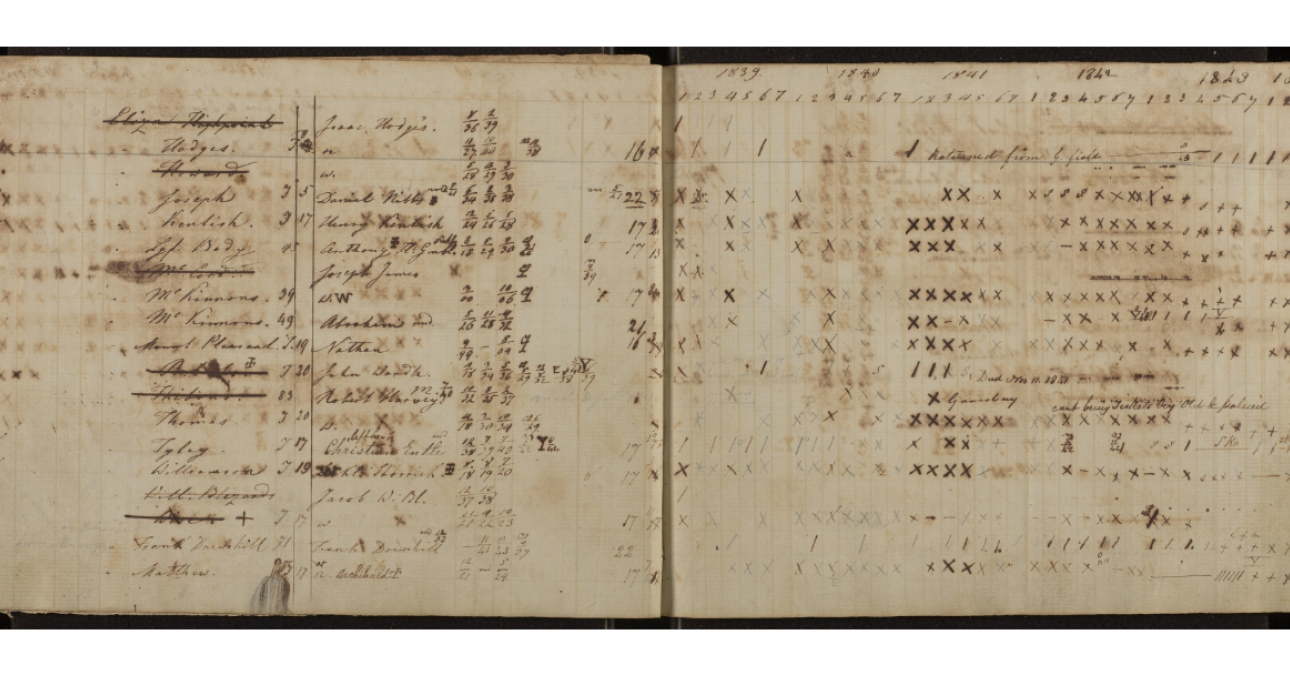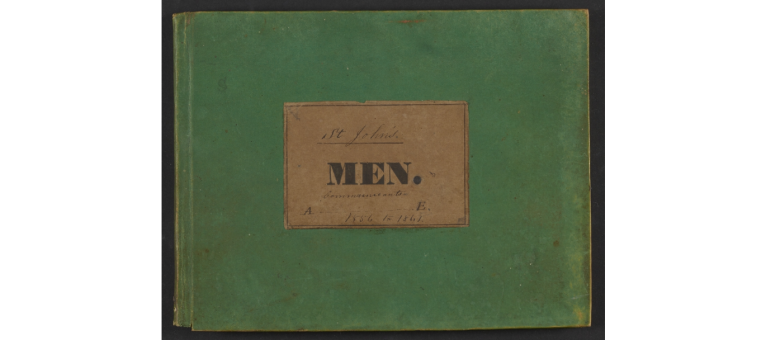
A Decade of Collaboration with Moravian Archives
Above: Pages from a Speaking Book, containing a catalog of female members of the Moravian Church in Antigua, 1839-1844 (All images courtesy of the Moravian Archives, Bethlehem, PA)
Frequent hurricanes, high humidity, and the swarming presence of insects and other pests take an inevitable toll on paper collections. In the Caribbean islands of the Eastern West Indies, the 18th and 19th century records of the Moravian Church were relentlessly buffeted by the extremes of the tropical environment. Dating back to the first arrival of the Moravians on the islands in 1732, the records they kept contained detailed and unique information on the free and enslaved people of color in the region. But because of their condition, the information remained inaccessible—with most of the records too fragile to be digitized or exhibited.
Manuscript volumes from the Eastern West Indies Records Preservation and Digitization Project of the Moravian Archives began arriving at CCAHA for treatment in 2018. Senior Conservation Assistant Jilliann Wilcox recalls that the volume she worked on contained pages that “were so, so brittle.” Thousands of broken, loose fragments were scattered throughout the volume. Along with other members of the team assigned to these treatments, Jilliann’s formidable task was to prepare the volume for digitization.
Many projects at CCAHA start slowly, often taking years to unwind. CCAHA’s involvement with the Eastern West Indies project for the Moravian Archives started in 2010 when two of CCAHA’s preservation specialists visited the site to conduct a preservation needs assessment and the collection caught their attention. Laura Hortz Stanton (now CCAHA Executive Director, then Director of Preservation Services) remembers returning from the assessment very excited about the collections.
For context – the Moravian Archives collects, preserves, and makes available the records of the Moravian Church in North America and the Caribbean, starting from the 18th century to the present. The Moravians came to the Caribbean to bring Christianity to the enslaved population of the region, leading to the establishment of the first Afro-Protestant mission churches in the Caribbean, as well as in the Americas as a whole.

Above: After treatment image of a church register from the Moravian Church in Antigua, 1771-1798
Luckily, the practice of record-keeping has always been an integral part of Moravian society. As a result, their record-keeping in the Caribbean was remarkably detailed, including information that cast new light on the lives of the enslaved people and the plantations where they worked, lived, and died. For instance, the church registers, catalogs, and membership lists from the island of Antigua include information about the members’ (or prospective members’) baptismal names, the name of the plantation where they worked, when they were baptized, when they became full church members, where they went if they left the mission church, who they married, and when they died.
The significance of the information in these records cannot be overstated. However, years and years of previous exposure to a tropical climate has severely damaged the records. While they are now kept in a stable environment at the Moravian Archives, the records remain extremely fragile and in many cases were completely inaccessible to researchers.
In the 1960s, the Caribbean records were transferred from the islands to the Moravian Archives where they could be stored in a more stable environment, with climate-controlled vaults and a fire suppression system. But the collections were large and the poor condition of much of the material was daunting, posing a large challenge.

Above: Cover of a speaking book, containing a catalog of male communicant members of the Moravian Church in St. John’s, Antigua
This was the situation when CCAHA staff first visited in 2011. A step-by-step process started to emerge, with each project naturally leading to the next. After the preservation needs assessment, a CCAHA conservator performed a one-day conservation assessment, and this in turn led to a much more comprehensive seven-day item-level collection survey, performed in 2016 with funding from the National Endowment for the Humanities (NEH). Using data from this collection survey, the Moravian Archives staff selected material for two pilot projects: Archiving Antigua, a digitization project which received funding from the Council for Library and Information Services (CLIR), and the Eastern West Indies Records Preservation and Digitization Project, a treatment and digitization project with funding from NEH. To help with funding, CCAHA Director of Development Lee Price worked with the Moravian Archives Director and Archivist Dr. Paul Peucker to help define project scopes and prepare grant applications.
The five volumes of the Eastern West Indies Records Preservation and Digitization Project suffered from iron gall ink deterioration, torn and broken leaves, insect damage, and liquid stains, as well as missing pages and many loose fragments. Conservators carefully treated each leaf in every volume, relaxing creases and mending tears. For two of the volumes, each leaf received an aqueous calcium phytate treatment to arrest the corrosion of the iron gall ink and suspend ongoing damage to the paper.
Faced with a bewildering array of fragments, Jilliann Wilcox carefully set about sorting the fragments into groups, working with CCAHA Senior Book Conservator Richard Homer to organize the pages and fragments. Placing the fragments was like working on a jigsaw puzzle with hundreds of pages and an unknown number of pieces, but Jilliann recalls that the process became easier the longer she worked on it. One volume required over 200 hours in treatment.
Two volumes arrived partially bound and were disassembled to release the pages for treatment. Before they were rebound, the treated leaves were passed to the digitization team for scanning. Digitizing the leaves while unbound allowed for the full pages to be captured, without losing any information to distortion or the shadow of the gutter.

Above: After treatment image of a church register for male members of the Friedensthal Mission in St. Croix, 1744–1832
As the Archiving Antigua CLIR grant only funded digitization and not treatment, a series of 110 volumes was selected that posed minimal risks for the handling involved with digitization. Prior to imaging, each volume was inspected by a CCAHA book conservator, who provided special handling instructions. These volumes were imaged on a Linhof book imaging easel, which contains two panels that are independently adjustable to reduce stress on fragile bindings. The pages were captured using a Phase One 100MP digital camera, which allowed for the capture of 2-page spreads in one capture with a single click of the shutter. High resolution TIFF files were provided to the Moravian Archives.
As the CCAHA imaging team continued to work, another team at the Moravian Archives began adding a remarkable amount of metadata, ultimately uploading the files to the Digital Library of the Caribbean. The resulting online archive not only makes the material accessible to researchers and scholars, but vastly increases its discoverability through searchable terms and descriptions. “After following this project for ten years, it has been such a treat for me to see this material available online at last!” Laura says, thinking back to her first 2010 visit to the Moravian Archives. “The content of these documents is so important to history. It’s been an honor for CCAHA to play such an important role in making this material freely available to everyone, from researchers to genealogists and, above all, to the descendants of the people mentioned in these pages.”
To view examples of the material, please visit dloc.com and search “Moravian Archives.”


